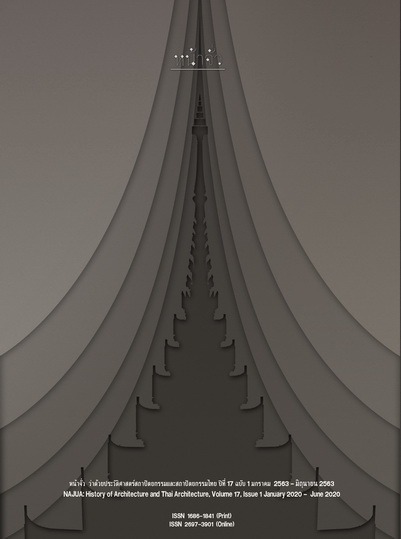Place Evolution from Klong Lat to Soi Lat: Transformative Urbanism from Water-Based to Land-Based City of Bangkok
Main Article Content
Abstract
The illustration of Bangkok settlement could be explored through a history of how ruling classes and governors developed the city, but the specific pattern of how people bond in space is a corner- stone demonstrating urbanism and its dimensions. This paper presents Bangkok's urbanism concerning experiences in spaces, consisting of a review of Bangkok evolution from water-based to land-based city, urban change along Klong Lat and Klong Kud, shortcut- and manmade-canal, on the one hand, and that along primary roads, Soi and Soi Lat, local streets and street shortcuts of the city, on the other. Aspects of urbanism were analysed of settlements, movement, building fabric, land utilisation, and townscape; relevant dimensions were also analysed of society, culture, development, classes, and communities.
Klong Lat is the beginning of Bangkok urbanisation, and Soi Lat currently takes part to transform the city. Over 238 years, since Rattanakosin was established in 1782, the city's weave pattern has been delivered by a diversity of social groups and classes. Ruled by Ayutthaya tradition of urban pattern, the settlement related to water channel was developed in Bangkok where waterways were cut to encompass the city. The aground commercial communities of many ethnic groups, however, were found by a transitional time from traditional to market-driven society. City walls and fortresses less played a role regarding the social and economic reform and the changing pattern of palaces, built canal and roads led the city instead. The rise of capitalism as well as middle-class consolidated and made the city further expand with the morphology of high density built form along primary roads while several communities were found in Soi delivering diverse classes and residential types. Currently, high-dense urbanisation along main roads encloses a large land area of Soi communities, shaping the superblock morphology of Bangkok. Configurational limitation of the superblock by itself results both in need of street shortcuts and in the pressure on local streets to carry urban mobility. Nowadays, Soi Lat becomes an urban tissue of dynamic places to deal with land development and highly mixed cultural landscape.
The city is a product of diverse social groups, locations, territorial spaces and transformations. Multiple perceptions of Bangkok urbanism is the result of varied morphologies and patterns of how they take place in the city. They are a sustain of water-based and land-based communities in spaces, a dispersion of urban expansion contributing to ongoing emergence of new morphologies, and a reproduction of urbanism regarding morpho-logical replacement that newcomer's land utilisation set over local communities. These spatial patterns and multi-dimensions affect ways in which peoples experience the city, while differences in social classes and spaces are fundamental in defining Bangkok urbanism.
Downloads
Article Details

This work is licensed under a Creative Commons Attribution-NonCommercial-NoDerivatives 4.0 International License.
References
Askew, Marc. Interpreting Bangkok. Bangkok: Chulalongkorn University Printing House, 1994.
Chatthip Natsupha. sētthakit mūbān Thai nai ʻadīt [The Thai village economy in the past]. Bangkok: Sangsan, 1984.
Chris Baker and Pasuk Phongpaichit. prawattisāt Thai rūamsamai [A history of Thailand]. Bangkok: Matichon, 2014.
Duangchan Aphawatcharut Charoenmuang. mư̄ang nai sangkhom Thai [City in Thai society]. Chiang Mai: Within Design Press, 1999.
Kamthorn Kulachol. “kānsamrūat mō̜radok thāng watthanatham nai krung Rattanakōsin chan nō̜k [A survey of cultural heritage in the outer Rattanakosin area].” Najua: Architecture, Design and Built Environment 20 (September 2003-August 2004): 11-39.
Kamthorn Kulachol. “wiwatthanākān thāng kāiyaphāp khō̜ng krung Rattanakōsin fang tawanʻō̜k: tangtǣ kō̜n rœ̄m sāng krung čhonthưng samai plīanplǣng kān pokkhrō̜ng [The evolution of old Bangkok morphology: From its inception to the regime change era].” In Silpakorn Journal: Special Issue for Rattanakosin 200 years, 221-241. Bangkok: Silpakorn University, 2525.
Kamthorn Kulachol. “kān fư̄nfū saphāpwǣtlō̜m bon thanon rāt damnœ̄n klāng: prasopkān čhāk phākpatibat [The rehabilitation of the middle Ratcha-damnoen Avenue: An experience from hands-on implementation].” Najua: Architecture, Design and Built Environment 15 (January-December 1997): 39-58.
Kaothien, U. and D. Webster. “The Bangkok region.” In Global city regions: Their emerging forms, 23-37. Edited by R. Simmonds and G. Hack. London: Spon, 2000.
King, R. Reading Bangkok. Singapore: NUS Press, 2011.
Nangnoi Saksri and others. ongprakō̜p thāng kāiyaphāp krung Rattanakōsin [Physical elements of Rattanakosin]. Bangkok: Chulalongkorn University Press, 1991.
Natthakan Tamsamsu. bān khō̜ng khončhon mư̄ang [Home for the urban poor]. Accessed March 30, 2018. Available from https://waymagazine.org/home
Netnapis Nakavachara. “Migration and the primacy of Bangkok.” Espace, populations, sociétés, no.1 (1985): 79-86.
Nithi Eoseewong. “khon chan klāng Thai kap prachāthipatai [Thai middle class and democracy].” Matichon (January, 23, 2017).
Noppanun Tapananon. nawa withī mư̄ang thān nam [Water-Based Urban Morphology]. Bangkok: Chulalongkorn University Press, 2013.
Pheereeya Boonchaiyapruek. “Spatial capital in Bangkok: A study of diversity and adaptability in urban transform process.” Ph.D. dissertation, University College London, 2017.
Punnee Bualek. “phatthanākān thunniyom nai prathēt Thai [Capital development in Thailand].” Silpakorn University Journal 19, 1 (2000): 9-39.
Singhanat Sangsehanat. “rūp santhān sō̜n thap nai yān sukhumwit: khwāmlāklāi thāng phūmisāt chœ̄ng prawattisāt khō̜ng mư̄ang krung thēp [Superimposed morphology in Sukhumvit: Diversity of Bangkok historico-geography].” Najua: Architecture, Design and Built Environment 30 (January-December 2016): 3-26.
Srisak Walliphodom. phūmisāt-phūm lak: tang bānpǣngmư̄ang [Geography-landscape: Urbanisation]. Bangkok: Mưang Boran Press, 2000.
Sujit Wongthes. Krung Thēp māčhāk nai? [A historical background of Bangkok]. Bangkok: Dream Catcher Press, 2012.
Thorn Pitidon. khon chan klāng (bon) phū mai khunkhœ̄i prachāthipatai [Upper-middle class and democracy]. Accessed April, 1, 2018. Available from http://www.aftershake.net
Wichaya Komin and Baworn Sapsing. kānsāng khwāmpen tham thāng sangkhom rư̄ang thīyūʻāsai nai klum khončhon mư̄ang [Developing social justice in the topic of urban poor housing]. Bangkok: Chulalongkorn University Press, 2014.


